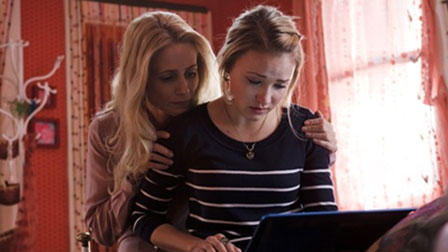
Cyberbullying is a new phenomenon that came into existence with the invention of the Internet. Cyberbullying is a form of harassment and humiliation through the virtual world. Research reported that 83% of the research participants in Indonesia experienced cyber victimization. This makes cyberbullying a significant problem among Indonesian teenagers and therefore deserves serious consideration.
To be a victim of cyberbullying can be very traumatic as it can hurt you 24 hours a day, 7 days a week. In 2011 the American movie Cyberbully came out. The movie explores the life of the teenage girl Taylor Hillridge. When Taylor turns seventeen, her mother gives her a computer and Taylor starts to use social media for the first time. As a joke, fellow high school students start to say bad things about her on a social networking site. The cyberbullying gets so out of hand, that Taylor does not want to go to school anymore in fear of what other students may say to her. She is afraid that others believe the lies that are being said about her online. At some point Taylor starts to think that it is her own fault that her classmates are so mean to her and she begins to hate herself. By showing Taylor’s case and following the desperation that takes hold of her, the makers of the movie want to warn viewers of the consequences of cyberbullying and give suggestions on how to act against it.
The act of cyberbullying often seems anonymous, so people generally say more than they would in a face-to-face situation. An interesting notion in the movie is that the perpetrator of cyberbullying does not realize that her words hurt the victim so much. To her, her actions are a form of joke. Taylor however, believes the painful words of her bully and assumes that it is the way everyone thinks about her. She attaches a lot of importance to what is being said online.


What makes cyberbullying more intense than traditional bullying, is that a single aggressive text or message is repetitive in nature. A message on social media is open for many people to see and it can be viewed repeatedly by the target whenever they go on to the website. Furthermore, thousands of people can view insults posted online because once something is out in cyberspace, there is no way to control what happens with it. There is no way to delete it completely. Traditional bullying can be defined as an aggressive act that is intended to distress or cause harm to the target, that is usually repeated over time, and that occurs among people among whom there is a power imbalance. This power imbalance can be physical, social, relational, or psychological. Other than with traditional bullying however, direct observation of the effects of bullying on the victim is not possible because of the online nature of the interaction. It impairs chances of empathy and remorse on the part of the perpetrator. This is different from traditional bullying incidents at school, where a few dozen at most may be witness.
Retaliation is the action most often taken by the victims in order to make the bully stop their harassment. However, as a counsellor suggests in the movie, this can work like throwing oil onto the fire and makes the situation worse. Another tactic that Taylor attempts is to ignore the bullying and act as if she does not care. Her last option is to call out to the bully and tell her how much her words hurt. Cyberbullying is often thought to be a problem of mostly female middle school students. However, it also occurs amongst adults and even though females are more likely to engage in cyberbullying than males , it also happens extensively amongst teenage boys.
Youth, whose parents are more attentive of the online activities of their children and communicate with them about Internet safety, show lower cyberbullying victimization rates. Therefore, teenagers should be informed on how to engage wisely in online social media, to cope with acts of bullying and to manage themselves appropriately when cyberbullying occurs.
Soeliah Hellwig
Universiteit Van Amsterdam
Rifka Annisa undertakes research, establishes support and education programs, and trains communities to deal with gender-based violence. With all this knowledge and expertise, Rifka Annisa also compiles books on how to understand gender, the role of Islam, Indonesian law and the way we run our programs. These small books provide valuable insight into the work we do and address many frequently asked questions from people wondering about the issues of violence against women in Indonesia.
Book 1: Understanding Gender and Violence Against Women

This book explains what gender is and how rigid gender roles lead to a culture that accepts and perpetuates violence against women. Gender is different to biological sex, as the different anatomies we have hold no inherent meaning. Contrastingly, gender is an assigned construction of rules that drastically affect how people live their lives. Common stereotypes of male and female include women staying at home, being passive and being more emotional while men work outside the home, are assertive and are seen as rational. These expected behaviours of people with different physical anatomy are something humans have created, and it severely restricts the rights of women. From marginalising them economically to restricting their participation in social and political life, women constantly receive fewer opportunities than men. Women also statistically experience more domestic violence from men close to them. From Rifka Annisa’s research, we estimate that on the island of Java a woman is raped every 5 hours.
Not only do women experience more violence, but victim-blaming, and the stereotyping and shaming of women who are assaulted is a common practice in Indonesian culture (and in most cultures all over the world). Women are seen as wanting attention, and teasing men with how they dress or what they were doing. If the violence occurs within their household, people ask why the woman stayed, and blame her assault on her ‘choice’ to stay with an abusive husband. In reality, regardless of clothing or behaviour, women are still assaulted, raped and abused by men. Further, providing for their children, economic dependence, psychological trauma and threats from their partners often restrict women from simply leaving an abusive household or situation. This fear and stigma that their community will not believe them or blame them for being abused is a huge problem in addressing the issue of gender-based violence – especially as it removes responsibility of abuse from the man/perpetrator.
Understanding Gender and Violence Against Women is the perfect book for an articulate explanation of how gender and violence influence each other, and how we need to think more critically about our current culture.
Book 2: Is Islam Discriminatory?

Islam overwhelmingly emphasises equality for all, with a responsibility to all of humanity to be charitable and peaceful. However, masculinist and patriarchal interpretations of the Al Qur’an are often quoted to justify gender inequality. Muslims who use Islam to maintain gender roles and even violence against women, are violating the basic tenant of sharia, i.e. maslahat (benefit, well being).Believing that men are better leaders or that women are taking rights from ‘outside’ of those given to them in Islam, they ignore the vast amount of teachings that emphasise equality for all. The fact that rights for women have been ignored within the Muslim community for so long shows an ignorance and biased perception of Islam used to benefit men.
Islamic laws and teachings that are explicitly sexist towards women do exist, such as the need for two women to testify versus one man. What Rifka Annisa emphasises is that these laws were written 14 centuries ago, at a time when women were even more oppressed. The Al-Qur’an and other Islamic writings are very gender progressive for the time in which they were written, however there are some parts that reflect the context of that society. As Muslims who are currently practicing Islam in the 21st Century it is important to study what is relevant in today’s society. Gender equality, equal relations between wife and husband, the application of logic and the process of learning are vital to our understanding of Islam.
Islam itself is not discriminatory, however patriarchal Muslim communities can use the Al-Qur’an and other Islamic texts to oppress women. Therefore, it comes down to changing cultural and social attitudes, and focusing on the most important principles of Islam such as equality.
3. Why Allow Differences?

Gender roles are a socialised phenomena created by humans, they are not natural – particularly in terms of education, skills etc. Many people believe that gender roles are genetic because of long cultural traditions perpetuated by the community, the government and other systems.
A commonly asked question is that if gender roles work in harmony and create a good relationship between men and women in a community, is that still harmful? An important feature of equality is choice. Do people have the choice to act outside of gender roles, even if those gender roles work in harmony in that community? If they cannot choose to have different opportunities, then inequality is still be an issue.
The best way to address inequality is to begin educating people with curriculums that are non-sexist. From children to adults, it is important to start teaching gender equality within our communities. Government policy must also strive to be gender-aware, particularly in acknowledging the struggles of women and history of sexism.
Book 4: Justice For Who?

The Indonesian legal system is currently still unequal in its treatment of women. It is particularly limited in protecting them from violence, rape, exploitation and domestic abuse. Sexual assault legislation is often only applicable to cases of pre-marital assault, which makes it very difficult for married women who are raped by their husbands to get legal help. Conviction and sentencing also shows that men usually face no legal consequences for domestic violence as police, courts and society make coming forward and providing evidence very difficult. Additionally, poor women often do not have the time or money for lawsuits.
Divorce is legally accessible to all women in Indonesia, for Muslims through the Religious Court and for non-Muslims through the State Court. However women who are not yet married, also face complex issues. After having sexual intimacy, their partners might threaten to break up with them or refuse to marry them. This kind of coercive behaviour is unhealthy and abusive. Rifka Annisa advocates that all women should prioritise their safety over the idea of their virginity. Virginity is a social construct used to control women and abuse should not be put up with because of fears about virginity. Pregnancy outside of marriage is another common issue with a variety of options: getting married and raising the baby, raising the child as a single parent, putting the baby up for adoption or having an abortion. Islamic teachings are not consistent as to when life begins. Some sources quote conception, some 40 days and others 120 days – however abortion can be an option at any time that is best for the woman, and Rifka Annisa can organise this medical help.
Overall, the legal system is often a complicated and biased process for women however Rifka Annisa does offer legal support to any women survivors of domestic violence.
Book 5: Organising Ourselves

Rifka Annisa’s program for establishing Crisis Centres based in the community is one of our most successful ways of addressing violence against women in rural areas of Central Java. The program established in Bupati KDG Tc. II Gunung Kidul is an example of how Rifka Annisa based its Crisis Centre in the community so that the program became self-sustaining without outside help from Rifka Annisa’s main office in Jogja.
The first step is understanding what areas might be the most in need of a women’s crisis centre. While research has shown that all communities regardless of background have cases of domestic violence, there are some indicators as to areas with a larger domestic violence issue. These indicators include a high youth marriage rate, high divorce rate, high mortality rate for mothers and babies, high female suicide rate and high recordings of murders by and of women. After choosing an area, the internal systems and external systems that can be involved in a case of domestic violence should be identified. Internal systems include the victim and perpetrator, their families, neighbours and community. External systems include the hospital, police and the women’s crisis centre.
Rifka Annisa then focuses on putting together resources for changing the socialisation of gender, providing psychological and legal counselling and community organising in the region. A secretariat is also needed to keep documents from domestic violence cases. By working with the community, cooperating with people in the internal systems and making the benefits very clear, programs like a women’s crisis centre are more likely to be accepted. In the community of Tc. II Gunung Kidul, Rifka Annisa gave volunteers from the community a series of workshops, 10 days of work experience at the Rifka Annisa office in Jogja and helped them start running the women’s crisis centre in their community. These volunteers were organised into three groups, counsellors, educators and accountability/law keepers. The counsellors were trained in psychology and legal support, the educators were given gender awareness programs and the accountability groups were usually made up of village leaders and local government. In this way the women’s crisis centre in Gunung Kidul became independent and ran effectively on its own once Rifka Annisa stepped away.This is the model Rifka Annisa uses in many areas of Central Java to help women facing domestic violence in rural areas. []
Author: Bridget Harilaou (This email address is being protected from spambots. You need JavaScript enabled to view it.)
Student intern in the Media and Public Relation Division, Rifka Annisa